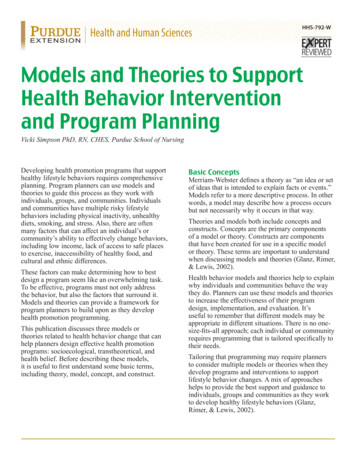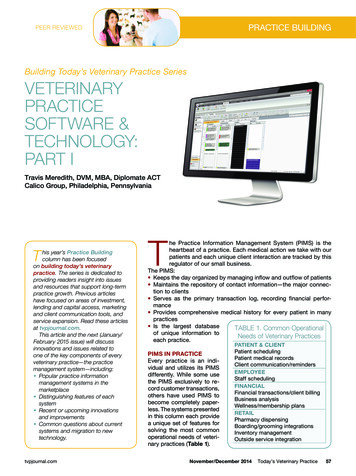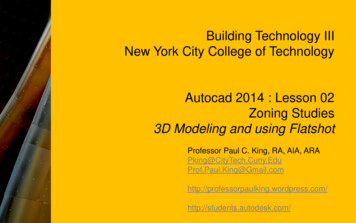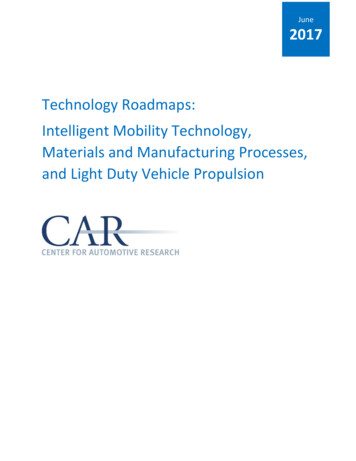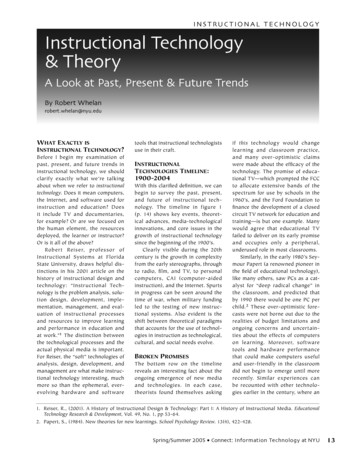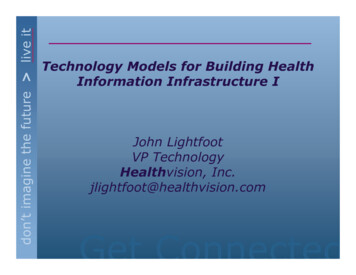
Transcription
don’t imagine the future live itTechnology Models for Building HealthInformation Infrastructure IJohn LightfootVP TechnologyHealthvision, Inc.jlightfoot@healthvision.comGet Connected
don’t imagine the future live itAgenda Value of Health Information Interoperability How does a community get there? Real-life RHIO example Technology Models Standards Challenges for a National ModelGet Connected
don’t imagine the future live itValue of Healthcare Information Exchange andInteroperability (HIEI): CITL Key Findings Standardized, encoded, electronic healthcareinformation exchange would: Save the US healthcare system 337B over a 10-yearimplementation periodSave 78B in each year thereafterTotal provider net benefit from all connections is 34B Net benefits to other stakeholders: - Payers 22B- Laboratories 13B- Radiology centers 8B- Pharmacies 1B- Public Health 0.1B Dramatically reduce the administrativeburden associated with manual dataexchange Decrease unnecessary utilization ofGet Connectedduplicative laboratory and radiology tests
don’t imagine the future live itCITL HIEI TaxonomyLevelDescriptionExamples1Non-electronic dataPhone, US Mail2Machine-transportabledataFax/Email withoutcategorization3Machine-organizabledataText reports, HL7 messages4Machine-interpretabledataLOINC-based lab results fromlab system; codifiedmedication hxGet Connected
don’t imagine the future live itHIEI National Net Cost-BenefitNet Return over10-yearImplementationAnnual NetReturn afterImplementationLevel 2 141B 22BLevel 3- 34B 24BLevel 4 337B 78BValue of HIE standards is the difference between Level 3 & 4Get Connected
in billionsdon’t imagine thefuture live it10-Year Cumulative Net Return by HIEI Level 400 300 200 100 -012345678910 (100) (200)Level 1Level 2YearsGet ConnectedLevel 3Level 4
don’t imagine the future live itThe Connected Healthcare Community Patient-centric design Collaborative Care Model Disparate IT systems All providers haveare unified through ashared informationarchitectureaccess to complete, upto-date sPatientsManagedCarePhysicians& StaffGet Connected
don’t imagine the future live itHow does a community get there?Four Step ProcessGet Connected
don’t imagine the future live itPhases¾ Strategic Planning¾ Governance¾ Funding Models¾ InformationSystems Strategy¾ InformationSystems Strategy¾ e-healthInteroperabilityPlatform¾ Implementation /Integration Services¾ Application / ASP /Service Delivery¾ Implementation /Integration Services¾ Application / ASP /¾ Ongoing TrainingService Delivery& Support¾ Connecting Hospitals, ¾ Office WorkflowLabs, PharmaciesOptimization¾ Connecting Physicians ¾ Benefits Analysis¾ Trading Partner¾ Connecting PatientsManagementGet Connected
don’t imagine the future live itImagine . . . . Connecting 8 competing hospitals, 2 competing reference labs,and thousands of physicians and pharmacies to build an entirecommunity’s shared patient record Providing an entire care team (primary care physicians,specialists, nursing staff and hospital staff) access to anintegrated patient record view Viewing historical and codified lab data from multiple labs(reference, in-patient and ambulatory) Delivering comprehensive current problem lists and allergies tothe point of care Having access to a patient’s medication history and knowledgetools that check allergy and drug to drug to reactions Driving formulary compliance on prescriptions and lower costsubstitutions for high prescribing physicians that save thecommunity as much as 15,000 per physician per year Providing a community infrastructure that supports EMRinteroperability so that physicians with different IT systems canshare relevant patient information among them Implementing all of this within a 3–6 month timeframeGet Connected
don’t imagine the future live itReality Taconic IPA (Mid-Hudson Valley, NY)has established an operating RHIO 1000 current users (400 physicians)using a shared data exchange 4 Hospitals, 2 Reference Labs(LabCorp and Quest) connected EMPI established to handle personidentity resolution System live and users trained within90 days of project kickoff Data Exchange (Connectivity)CDR – Shared Patient RecordCommunity Portal (Physician View)EMPI – Person ResolutioneResults Software Applications18 Hospital and Lab interfaces 3 EMR vendors (Allscripts, NextGen,GE) agree to interoperability w/ CCRand HL7 Data Exchange Contract Signed on October 1, 2004 –system live and users trainedDecember 31, 2004.Get Connected
don’t imagine the future live it“Stunning” InteroperabilityGet Connected
don’t imagine the future live itTechnology Delivered via an ASP model IBM servers on Intel architecture Portal built on a Microsoft platform Windows Server 2000/2003Internet Information ServerSQL Server 2000 Data exchange and routing via Cloverleafinterface engine EMPI services provided by Eclipsys Clinical vocabularies and libraries from IMO,Multum, Healthwise and othersGet Connected
don’t imagine the future live itHealthvision - Scale 1000 hospitals utilize servers daily Manage a Microsoft environment of approx 250servers Platform database grows 12-15% per month andcurrently is approx 2 TB in size Over 8 million unique patients in database Interface Engine processes approximately 310,000clinical transactions per day Support 2.0 Million unique users/month Over 11.7 TB per year in network trafficGet Connected
don’t imagine the future live itTechnology Model Regional Clinical Data Repository Longitudinal patient record across all systems Reference pointers back to images anddocuments Single sign-on to third party systems CCOW support Intelligent routing of HL7 and CCR data to EMRs Record Locator Service to find national records National exchange of clinical data among RHIOsGet Connected
don’t imagine the future live itClinical Advantages of a Regional CDR Effective re-use of clinical data Codified data for reporting, graphing, and clinicaldecision supportOngoing surveillance Hazardous conditionsMissed disease management opportunitiesPotential errorsAdverse effects Automatic alerts to providers Data from multiple sources combinedClinical alerting rules run across combined dataGet Connected
don’t imagine the future live itClinical Advantages of a Regional CDR Longitudinal, patient-centric view Multiple providers in multiple locations easily share datafrom multiple systems Proven physician and staff acceptanceGet Connected
don’t imagine the future live itTechnical Advantages of a Regional CDR Centralized security access model for easiermanagement of access to protected healthinformation Time to market CommonCommonCommonReusabledata frameworkconfiguration toolsimplementation processinterface libraries System performance and reliability End user not waiting while multiple systems are queriedEasily scalable with increased number of source systemsand usersGet Connected
don’t imagine the future live itTechnical Advantages of a Regional CDR Easy to integrate new modules Applications leverage a common set of clinical data andsystem services Not dependent on source system availability Easy to provide redundancy and eliminate single pointsof failure Person resolution complexity Fully decentralized system requires matching patientsacross multiple systems in real timeAllows timely human resolution of ambiguous matchesGet Connected
don’t imagine the future live itTechnical Advantages of a Regional CDR Standard legacy system interfaces HL7 and now CCRTakes advantage of built-in interface capabilities alreadybuilt in to most clinical information systems Centralized security model No need to provision multiple individual systemsGet Connected
don’t imagine the future live itStandards In order to deliver interoperability, adherence tostandards is key HL7 for registration and results exchangeCCR for visit snapshotICD9 for problemsCPT for proceduresNCPDP for pharmacyX.12 for eligibility and billing Problem with standards is definition HL7 too looseCCR doesn’t define vocabulariesGet Connected
don’t imagine the future live itHealthvision Interoperability platformGet Connected
don’t imagine the future live itChallenges to a national model Scalability Can systems scale from a few million patients to a fewhundred million? Identity resolution How do you quickly resolve patient identity acrosssystems nationally?Privacy concerns over a national patient identifier Security model How do you know who should get access to what data ona national level?Get Connected
don’t imagine the future live itThank You!Questions or CommentsJohn LightfootHealthvision, Inc.jlightfoot@healthvision.com(972) 819-4353Get Connected
Data exchange and routing via Cloverleaf interface engine EMPI services provided by Eclipsys Clinical vocabularies and libraries from IMO, Multum, Healthwise and others. don’t imagine the future G et Co n ct d live it Heal

